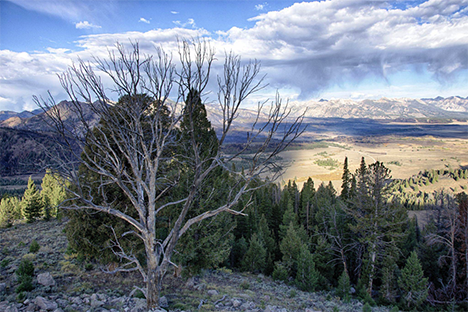
By Larry Barnes
In the last century a metastasizing forest of ghost trees has spread across 80+ million acres of western North America. Now, a small army of biologists has come to a conclusion based on reams of scientific studies. The U.S. Fish and Wildlife Service (Service) will soon list the whitebark pine (Pinus albicaulis) as a threatened species under the Endangered Species Act (ESA).
During the 31 years since the Service was first petitioned to designate the whitebark pine as threatened, the data have piled up along with the corpses of North America’s whitebark pines. Service biologists and bureaucrats are close to unleashing the power of the ESA to devise a plan to recover the whitebark pine — if they can.
The trouble began in about 1910 via the accidental introduction of non-native white pine blister rust (Cronartium ribicola) in British Columbia. This fungal pathogen has since spread, its lethal effects being exacerbated by mountain pine beetle (Dendroctonus ponderosae), climate change, and changing fire ecology. More than half of America’s whitebark pines are now dead but largely standing, ghosts of a former age.
Rising temperatures of the last century have favored mountain pine beetles and trees infected with blister rust are even more vulnerable to beetle infestation. Whitebark pines thrive at high elevations near treeline, but some fir and spruce species live there, too. A century of fire suppression has favored the expansion of fir and spruce forests into the whitebark pine’s realm, increasing competition with them as soils dry out through the effects of climate change.
Each species fills a unique niche, but some niches are so entangled with their ecosystems that their collapse may have far-reaching effects. And so it was that in 1991 a grizzly bear advocacy group (the Great Bear Foundation of Missoula, Montana) petitioned the Service to list the whitebark pine under the ESA. So why should a pro-grizzly group care about a timberline tree?
Whitebark pine seeds are a rich, fatty, high-protein food source that is briefly and seasonally abundant. Around 13 species of birds and eight species of mammals are dependent on them at some part of the year. Most famous among them is the Clark’s nutcracker (Nucifraga columbiana), a member of the jay and crow family having legendary whitebark pine seed harvesting and caching skills. Each cache may have only 3-4 seeds, but each bird may cache more than 90,000 seeds — and remember their locations! The whitebark pine is almost entirely dependent on the nutcracker for seed dispersal. When one finds a whitebark pine growing on some improbable ledge in a nearly vertical granite world, it was a Clark’s nutcracker that flew it there.
The Clark’s nutcrackers’ virtuosity in remembering thousands of seed cache locations is matched by the noses of the mammals that sniff out and raid them. The nutcrackers therefore overcache as insurance against hungry mammals. Moreover, whitebark pines have evolved a counter strategy against too much seed predation: masting. In some years, whitebark pines greatly overproduce a seed crop, nutcrackers go overboard in caching whitebark seeds, and not even grizzly bears can find and raid all of the nutcracker caches in an alpine habitat. The strategy may lead to a springtime bumper crop of pine seedlings.
I once camped near a whitebark pine forest in the Pioneer Mountains in October. During the two-day trip we saw black bears two or three times. The bears were systematically finding and eating nutcracker caches, leaving an evidence trail of bear-scat bundles of pine seed shells.
Whitebark pines occupy the frontier of forests abutting the high rocks and ice of the West. They are first in stabilizing the thin soil there and in sheltering and shading the snowpack, making it last. The alpine melt water is buffered and slowed by whitebark pine roots; the high country is fed by their energy-packed seeds. The whitebarks modulate a cascade of water and ecological relationships, benefiting a downhill, downstream world of interconnections of which we are a part.
Larry Barnes retired from 26 years as a biology teacher at Wood River High School and is now transitioning to spending more time exploring the natural world.


